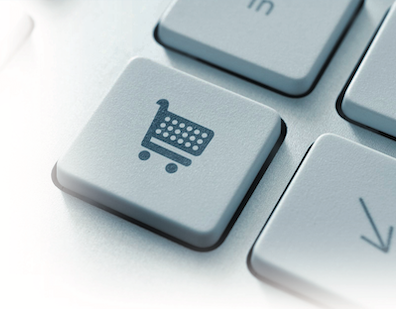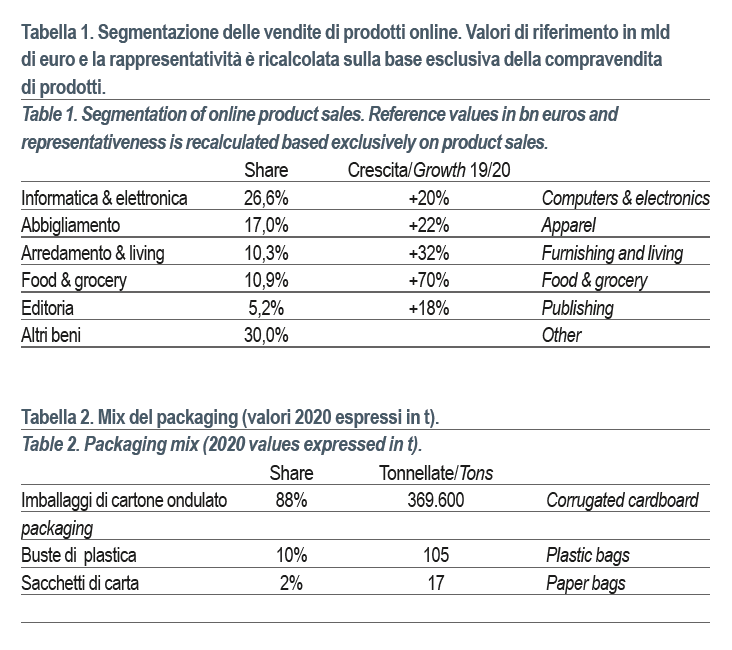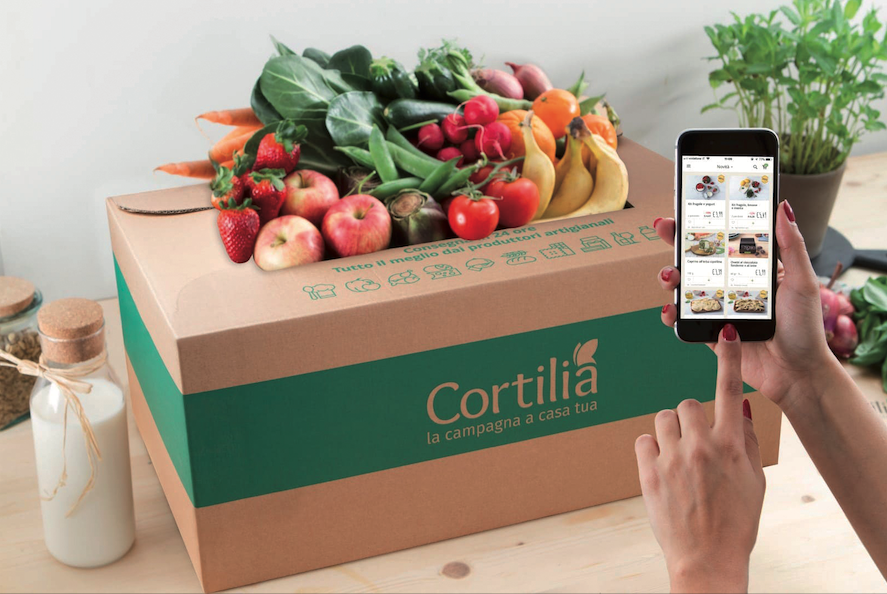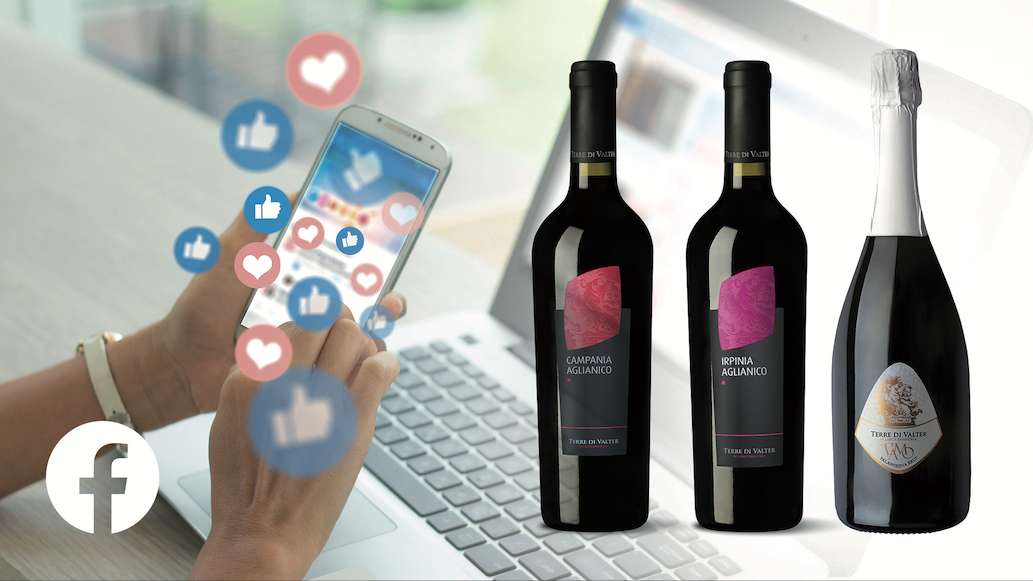Packaging & e-commerce – Data 2020
Among other things, 2020 will be remembered as the year of e-commerce and delivery. In fact, due to the multiple restrictions necessitated by the global pandemic, the use of online shopping has skyrocketed. And it was above all the purchase of consumer and instrumental goods that drove the growth of the sector since, due to the global health situation, purchases related to services, in particular tourism and travel, marked the greatest declines.
 Our habits have therefore been drastically changed, leading Italy to an important acceleration in the use of e-commerce: according to the analysis carried out by the Milan Polytechnic in the publication “Osservatorio e-commerce B2C”, online sales of goods alone have increased in 2020 by over 30%, reaching 30.6 billion euros.
Our habits have therefore been drastically changed, leading Italy to an important acceleration in the use of e-commerce: according to the analysis carried out by the Milan Polytechnic in the publication “Osservatorio e-commerce B2C”, online sales of goods alone have increased in 2020 by over 30%, reaching 30.6 billion euros.
Without a doubt, it is food spending that has recorded the highest growth rates and the habit of online purchasing has been maintained even after the lockdown, considered by 36% of families to be not only the most convenient mode, but also and above all the safest from a health point of view to avoid unnecessary contacts.
But it’s not only consumer product purchases that will benefit from this epochal change because, while still representing a small part of consumer purchases, at least in Italy, e-commerce will become increasingly relevant, albeit at a slower pace, even in our country.

Market and size
Analyzing the purchase and sale of goods alone in 2020, the first estimates speak of about 420 million shipments in Italy to be traced back to B2C e-commerce of goods, resulting in a consequent number of packages envelopes and bags that traveled across our country and between the streets of our cities, with an increase of over 30% compared to 2019.
This growth is in addition to the +21% recorded also in 2019.
E-commerce related to the purchase and sale from Italian sites to Italian and foreign consumers of goods only recorded a turnover in 2020 of 23.4 billion euros.
The market is divided between different types of goods traded, where each has its own representativeness compared to the total turnover (table 1).
The segmentation of the area that refers to trade in goods only sees the presence of six different types of market:
• Food & Grocery, an area that includes both home meal and grocery delivery, i.e., purchases of fresh or packaged food, household and personal care products, typically sold in supermarkets. In this analysis we are referring to products purchased online.
For this category, the growth rate in 2020 is the highest recorded, +70% over 2019 (2.7 billion euros);
• Computers and consumer electronics. The growth rate recorded for this product category is around 20% (6.2 billion euros); Distance learning and smart working have undoubtedly influenced the trend;
• Apparel. Although online sales grew by 22% (3.9 billion euros), the positive trend failed to lift the fortunes of the entire sector which, in 2020, recorded very sharp falls;
• Furniture and Home Living. The area registered a 32% growth in e-commerce (2.4 billion euros).
• Publishing. Compared to 2019, the purchase of books made online grew by 18% ( 1.2 billion euros).
• Other goods. The area includes all other types of products - toys, photo printing, stationery, etc.. - and e-commerce is up 28%.

What has changed in packaging
In 2020, in Italy, there were approximately 369,700 tons of packaging used for the shipment of goods bought and sold online.
In addition to having induced significant changes in the dynamics of online purchases, the global pandemic has also strongly influenced the types of packaging used to handle shipments of goods.
As repeatedly pointed out, e-commerce does not affect the packaging mix in relation to the primary packaging, i.e. the one in direct contact with the packaged product, which does not change whether it is purchased online or in store.
What does change is how the good is delivered to the home.
The significant growth in the food & grocery sector has therefore changed the segmentation of the packaging of shipments, modifying the types and relative market shares.
The use of corrugated cardboard, both as transport packaging and as protective packaging, is 88% in 2020.
As far as plastic is concerned, in addition to envelopes, there are also bags, mainly used for grocery deliveries; if the total amount of packaging used in this sector is 100, the incidence of plastic is 10%.
The remaining 2% is therefore attributable to paper bags, mainly used for food delivery (table 2).
It should be noted that, with the restrictions implemented for the restaurant industry, restaurants and bars have also equipped themselves for home delivery, generally using paper bags.
In this regard, it is necessary to open a small parenthesis: the increase in delivery activity on the part of restaurants and bars has driven another positive effect in the area of packaging, relative to the packaging of ready-to-eat foods.
Also the corrugated cardboard packages used for take-away pizza, plastic, aluminium and cardboard trays as well as flexible packaging have been added, and the “weight” of the area is, in fact, around 137 thousand tons of packaging.

In conclusion
The e-commerce phenomenon is destined to assert itself over time, with Italy catching up with the rest of Europe.
As a consequence, the packaging world will have to pay more and more attention to this purchase modality that, potentially, opens countless outlets.
The packaging industry, thanks to the capacity for technological innovation of which it has always shown itself to be capable, will certainly not let this opportunity slip by.
The fact is that intelligent packaging, capable of maintaining the organoleptic characteristics of food for as long as possible, or packaging that will better facilitate the transport and handling of goods, could obtain certain benefits from meeting the needs of this growing market.
Barbara Iascone
Istituto Italiano Imballaggio





















